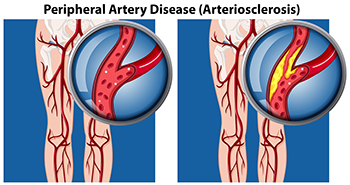Risk Factors and Symptoms of PAD

Peripheral artery disease involves the narrowing of blood vessels to the extremities, especially common in the lower legs. This occlusion is the result of a buildup of fatty deposits in the arteries, restricting blood flow to the legs, feet and toes. Risk factors for peripheral artery disease, or PAD, include being over 60 years old, smoking, high blood pressure, diabetes, and high cholesterol. The most common symptom is pain and weakness in the legs that may get better after resting. Other symptoms include numbness and a feeling of cold feet. Brittle toenails and toenails that grow slowly are other signs of PAD, along with sores or ulcers on the skin of the legs and feet that take a long time to heal. If peripheral artery disease goes undetected, it can cause extremely serious problems, including heart attack, stroke, or limb loss. To find out if you have PAD, please consult a podiatrist who can perform various imaging and other tests and discuss appropriate treatment options.
Peripheral artery disease can pose a serious risk to your health. It can increase the risk of stroke and heart attack. If you have symptoms of peripheral artery disease, consult with one of our podiatrists from Westside Podiatry Center, LLP. Our doctors will assess your condition and provide you with quality foot and ankle treatment.
Peripheral artery disease (PAD) is when arteries are constricted due to plaque (fatty deposits) build-up. This results in less blood flow to the legs and other extremities. The main cause of PAD is atherosclerosis, in which plaque builds up in the arteries.
Symptoms
Symptoms of PAD include:
- Claudication (leg pain from walking)
- Numbness in legs
- Decrease in growth of leg hair and toenails
- Paleness of the skin
- Erectile dysfunction
- Sores and wounds on legs and feet that won’t heal
- Coldness in one leg
It is important to note that a majority of individuals never show any symptoms of PAD.
Diagnosis
While PAD occurs in the legs and arteries, Podiatrists can diagnose PAD. Podiatrists utilize a test called an ankle-brachial index (ABI). An ABI test compares blood pressure in your arm to you ankle to see if any abnormality occurs. Ultrasound and imaging devices may also be used.
Treatment
Fortunately, lifestyle changes such as maintaining a healthy diet, exercising, managing cholesterol and blood sugar levels, and quitting smoking, can all treat PAD. Medications that prevent clots from occurring can be prescribed. Finally, in some cases, surgery may be recommended.
If you have any questions, please feel free to contact one of our offices located in Liverpool, Camillus, Skaneateles, Oswego, and Cicero, NY . We offer the newest diagnostic and treatment technologies for all your foot care needs.
